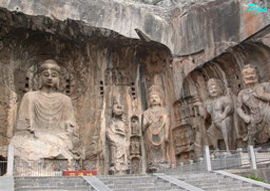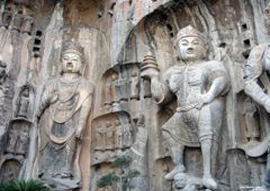The Longmen Grottoes, located near Luoyang, Henan Province, are a treasure house of ancient Buddhist cave art. The grottos were hewed and carved during the Northern Wei Dynasty (386-534),  when the rulers relocated their capital at Luoyang near the end of the 5th century. At that time Buddhism was spreading east into China and was venerated by the imperial court. The Buddhists adopted the practice of carving rock temples, dedicated to the Buddha. when the rulers relocated their capital at Luoyang near the end of the 5th century. At that time Buddhism was spreading east into China and was venerated by the imperial court. The Buddhists adopted the practice of carving rock temples, dedicated to the Buddha.
The construction of the Longmen Grottoes began in 493 during the reign of Emperor Xiaowen and continued through the successive six dynasties, including Tang and Song, for a span of over 400 years. Altogether there are 1,352 caves, 785 niches, more than 97,000 statues of the Buddha, Bodhisativas, and Arhats, and 3,680 inscribed stone tablets along the 1-km-long cliff of Mt. Longmen on the west and Mt. Xiangshan on the east of the Yihe River south of Luoyang.
One third of these cave sculptures belong to the Northern Wei Dynasty and two thirds to the Tang Dynasty. The style of sculpture, the design of clothing and the facial expression on statues, as well as carving methods show little foreign influence, rather they exhibit the pinnacle of development of Chinese grotto art. The 11 Buddha statues in the Binyang Cave, typical Northern Wei carvings, represent a style in transition from the simple and compact depictions in the Yungang Grottoes of Datong, Shanxi Province, to the vigorous and realistic Tang Dynasty sculptures.
While the cave sculptures of the Tang Dynasty are of a vigorous, elegant and realistic style, the stone statues in Fengxian Cave, carved under the edict of Empress Wuzetian (reigned 690-705), can be considered as the most typical of the period. These are composed of a 17.14-meter-high statue of Vairocana Buddha, and a series of pairs of Bodhisattvas, heavenly kings, protectors and worshippers. The huge statue of Vairocana Buddha is today praised as being the quintessence of Buddhist sculpture in China.
On November 30, 2000, the Longmen Grottoes were approved by the 24th UN Heritage Commission to be put on the List of World Cultural Heritage. |
